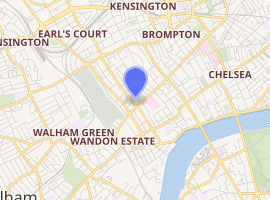Our Lady of Dolours, Chelsea
Our Lady of Dolours, also known as the Servite Church, is a Roman Catholic parish church run by the Servite Order in Chelsea, central London. The building was designed in Gothic Revival style by J. A. Hansom in 1873. It is Grade II listed with Historic England.[1] It stands next to St Mary's Priory, at 264 Fulham Road close to the South Lodge entrance to Brompton Cemetery in the Royal Borough of Kensington and Chelsea.[2] There is a mixed Roman Catholic primary school adjacent to the church and priory.
| Our Lady of Dolours, Chelsea | |
|---|---|
| Our Lady of Dolours, Chelsea | |

| |
| Location | 264 Fulham Road, Chelsea, London SW10 |
| Country | United Kingdom |
| Denomination | Roman Catholic |
| Religious order | Servite Order |
| Website | http://servitechurch.org/pages/home.htm |
| History | |
| Former name(s) | Our Lady of Seven Dolours |
| Status | Active |
| Founded | 1873 |
| Founder(s) | Father Philip Bosio OSM, Farher Agostino Morini OSM |
| Dedication | Our Lady of Dolours |
| Consecrated | 1875 |
| Architecture | |
| Functional status | Parish Church |
| Heritage designation | Grade II |
| Designated | 1984 |
| Architect(s) | J. A. Hansom |
| Architectural type | ecclesiastical |
| Style | Gothic Revival |
| Groundbreaking | 1873 |
| Completed | 1874 |
| Administration | |
| Archdiocese | Westminster |
| Clergy | |
| Archbishop | Most Rev. Vincent Nichols |
History
The parish and its church were initiated by two Italian Servite priests from Florence, Fr Philip Bosio OSM and Fr Augustine Morini OSM, who arrived in London in 1864. They came as missionary members of an ancient mendicant order to fill the shortage of Catholic priests in the wake of the English resumption of regular, public Catholic services after a break of nearly 250 years. From 1852-1869 St Mary's Church, Moorfields, built by the faithful, served as the first London diocesan seat of a re-established British Catholic church with a hierarchy.
Construction on the Fulham Road site began in 1874, led by Fr Philip Bosio OSM, with Joseph Hansom as architect. Hansom also designed the tower and priory frontage on Fulham Road (1879-80). It was originally named Our Lady of the Seven Dolours, but this was later simplified to the present dedication, (which is equivalent in meaning to Our Lady of Sorrows).[3] The church was consecrated by Cardinal Manning on 19 September 1875. From its beginning, when Roman Catholic parishes were being organised in the areas of Brompton, Fulham and Chelsea, the Servite Church was the most popular with the faithful, of whom crowds attended its services.[4]
The entrance colonnade passage by Hansom (1894) is unique in English churches. Other features include bronzes of the Redeemer and St. Peter by Mayer (1872), The Holy Face, after Lorenzo di Credi, 1895 and J. M. Swynnerton's Pietà (1896). The magnificent Gothic Reredos were unaccountably removed during a 1970s refurbishment. [5] The organ is by Henry Jones, built by Grant, Degens and Bradbeer in 1968.
See also
References
- Historic England. "Name: Our Lady of Dolours (1190777)". National Heritage List for England. Retrieved 15 July 2020.
- A to Z Directory on RBKC website
- F H W Sheppard, ed. (1983). "Plate 76: Church of Our Lady of Seven Dolours and St. Mary's Priory.," in Survey of London: Volume 41, Brompton". London: London County Council, British History Online. Retrieved 15 July 2020.
- Patricia E C Croot, ed. (2004). "'Religious history: Roman catholicism', in A History of the County of Middlesex". London: British History Online. pp. 259–263. Retrieved 15 July 2020.
- "Fulham Road – Our Lady of DoloursFulham Road, London SW10". Taking Stock - Catholic Churches of England and Wales. Retrieved 15 July 2020.
External links
- Official website
- The National Archives hold a record of the building, accessible at the London Metropolitan Archives